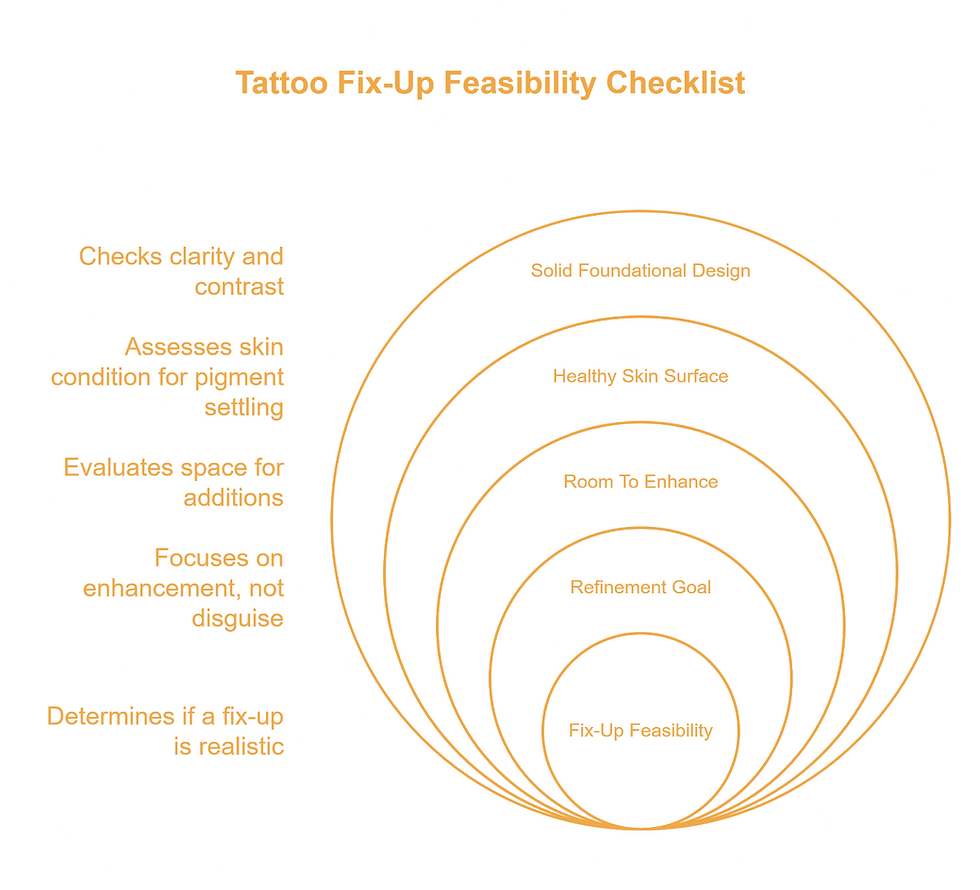Five Signs Your Old Tattoo Can Be Fixed (and Doesn't Need a Full Cover-Up)
- Fame Tattoos Insights Team

- Aug 29
- 7 min read
Updated: Sep 3
📌 Key Takeaways
Unsure whether to cover or fix your tattoo? Use a conservative, evidence-first check to decide.
Evaluate Structure First: If fading is the main issue and linework and composition still read cleanly, a careful fix-up can restore clarity without a full cover.
Know the Red Flags: Heavy blowouts, dense dark patches, or warped proportions indicate a cover-up or partial removal will likely serve you better.
Stage the Process: Verify fix-up skill via portfolios, agree on mockups, then re-line and re-saturate in a first pass before reassessing in daylight.
Use Space and Skin Health: Negative space to work with and even skin texture allow subtle shading and selective color to “remaster” the design.
Set the Right Goal (and Aftercare): Aim for refinement—not disguise—and follow disciplined aftercare in Miami sun and humidity to preserve crisp lines and color.
Evaluate, stage, refresh, protect.
Take a breath.
Picture a chair at a Miami studio. The afternoon light is harsh—the kind that makes faded outlines feel louder than they are. A familiar dilemma hovers: fix it up or cover it up? The fear is real: no one wants to make a disappointing tattoo worse. This guide is the calm in that moment—a simple, honest way to tell whether a careful fix-up could restore what you already have.
A tattoo fix-up is a technique where an artist improves an existing tattoo by re-lining, re-coloring, or adding new elements to enhance the original design without completely obscuring it. It’s like a professional remaster of a classic song—you aren’t replacing the song, you’re restoring clarity and richness. Picture your piece in bright Miami daylight: the outlines read cleanly, color feels present again, and the overall design finally looks like you. Start by evaluating fading vs. blowouts, underlying structure, and room to enhance—then book a specialist consultation to confirm the best path.
A tattoo fix-up is a technique where an artist improves an existing tattoo by re-lining, re-coloring, or adding new elements to enhance the original design without completely obscuring it. Think of it like a professional remaster of a classic song—you’re not replacing the track, you’re restoring clarity and richness. In practice, that means evaluating your piece for fading vs. blowouts, confirming there’s sound underlying structure, and planning targeted enhancements that bring it back to life.
“Fading + solid structure often means you can restore what you already have.”
According to the Fame Tattoos approach, start by evaluating structure before deciding on a full cover-up. That conservative-first mindset keeps control (and your options) in your hands.
The Honest Truth: Not Every Old Tattoo Needs a Full Cover-Up
Tattoo Fix-Up Services enables Faded Tattoo Restoration. That’s the core relationship. When linework is intact and the issue is primarily fading, re-lining and re-saturation are widely accepted practices to revive clarity and color depth.
Tattoo Fix-Up Services depends on Tattoo Artist Evaluation. Portfolio evidence—especially of fix-ups and cover-ups—matters more than promises. A specialist evaluates fading versus ink migration, composition, and skin condition to craft a plan.
Tattoo Fix-Up Services is limited by Blown-Out Lines and Scar Tissue. When ink has migrated beyond the line (a “blowout”) or where texture is uneven, crisp results are harder to achieve. In some cases, cover-up or partial removal becomes the better path. For medical guidance on removal options and limits, see the American Academy of Dermatology’s overview of tattoo removal methods (American Academy of Dermatology).
Tattoo Fix-Up Services complements a Cover-Up Consultation. If two or more red flags appear (see below), a cover-up plan can be explored without rushing decisions. Knowing both paths—fix-up or cover-up—reduces regret.
Tattoo Fix-Up Services improves Color Saturation and Line Definition. When conditions are right, targeted rework restores contrast and readability so the design feels like “you” again.
Key Terminology (Beginner Friendly)
Blowout: Ink that has migrated beyond the intended line, creating a fuzzy halo. Healthline.
Linework: The outlines and fine lines that define shapes and details.
Negative Space: Untattooed skin used to create contrast and make shapes readable. For a quick art concept refresher, see negative space in design fundamentals (Tate Art Terms).
Fix-Up Feasibility: The 5-Sign Checklist (Miami Edition)

Use this as your self-check before booking. If three or more signs apply, a fix-up is often realistic. If one or fewer apply—or if red flags dominate—consider a cover-up consultation or partial removal first.
Sign 1 — Faded Ink, Not Blown-Out Lines
Fading is predictable in Miami’s sunshine; it softens pigment but doesn’t distort shapes. If edges are still where they should be (no fuzzy halos), re-lining and re-saturation can bring definition back.
What to do next: Take daylight photos (no filters) and note areas where color once popped. Bring those photos to your consult.
Sign 2 — A Solid Foundational Design (Readable Shapes, Balanced Contrast)
Even simple designs can be strong when shapes read clearly and contrast feels intentional. If the original composition still “makes sense,” a fix-up can enhance what’s there rather than fighting it.
What to do next: Ask the artist to point out where contrast can be restored with line weight, shading, or selective color.
Sign 3 — Healthy Skin Surface (Minimal Scarring, Even Texture)
Skin condition guides technique. If texture is mostly even and scars are minimal, pigment can settle more predictably. Where texture is uneven, expectations should be adjusted.
What to do next: Flag any raised or shiny areas. A seasoned artist will discuss how that affects line crispness and color hold.
Sign 4 — Room To Enhance (Negative Space To Work With)
If there’s breathable space around key elements, an artist can add supporting detail, selective shading, or small connectors that improve flow—without hiding the story you still like.
What to do next: Ask about micro-additions: subtle background gradients, edge refinements, or tiny motif repeats that “remaster” the layout.
Sign 5 — Your Goal Is Refinement, Not Disguise
When the aim is refresh rather than hide, fix-ups shine. If the core subject still resonates—just looks tired—enhancement aligns with your outcome.
What to do next: Describe how you want it to feel in Miami daylight—cleaner lines, deeper color, or restored contrast. That clarity helps the plan.
When a Fix-Up Isn’t the Right Call
Red Flags: Heavy Blowouts, Dense Dark Patches, Distorted Proportions
Blowouts mean ink sits outside intended lines; re-inking won’t pull it back.
Large, dense dark fills can cap the ceiling on how much brightness a fix-up can deliver.
Distorted proportions (warped shapes, unreadable silhouettes) suggest fundamentals need rethinking.
If these dominate, consider a cover-up path or partial removal before rework. For removal options and expectations, consult dermatology guidance (American Academy of Dermatology).
What If…? Planning for “I’m Scared It’ll Look Worse”
That worry is normal—especially after a disappointing first experience. Use a three-step plan that puts control back in your hands:
Portfolio Check (Fix-Ups Specifically): Review before/afters of reworked tattoos, not just fresh pieces or large cover-ups.
Agree on Staged Enhancements + Mockups: Start with re-lining and selective color; preview layout refinements. Adjust between passes.
Stop/Adjust After the First Pass: Evaluate in natural Miami light after healing. If the outcome meets goals, proceed; if not, pivot to a cover-up consultation.
Look, this is the part where most people get tripped up: jumping straight to a giant cover-up before confirming whether a careful refresh would do. A staged plan keeps options open and risk lower.
Myth & Fact
Myth: “If you hate it, you must cover it up.”
Fact: If structure is sound and issues are mostly fading, a fix-up can restore clarity without a full cover.
Common Pitfalls to Avoid When Deciding on a Fix-Up

Mistaking Blowouts for Fading: Re-inking won’t undo ink migration; it can make edges look muddier.
Ignoring Composition Problems: Enhancement can’t fix unreadable shapes. If proportions are off, rethink the base.
Skipping Aftercare Planning (Miami Humidity): Healing in humid weather benefits from extra attention to cleanliness, gentle cleansing, and sun protection.
Your Next Step in Miami: Booking a Thoughtful Fix-Up Consultation
What to bring
Unfiltered daylight photos (close and full context).
Your short goal list: “Sharper lines,” “restore teal,” “clean up background.”
Any previous aftercare notes and known sensitivities.
How to discuss goals
Lead with refinement: “We like the subject, want clarity back.”
Ask for a staged plan (first pass: linework + selective color; second pass: subtle shading and flow).
Confirm how Miami sun and humidity factor into healing instructions.
What to expect
A reputable studio will review skin condition, blowouts vs. fading, and composition.
If fix-up fails the criteria, the conversation naturally shifts to a cover-up plan—without pressure. For a deeper walkthrough of what that looks like, see Tattoo Cover Ups and the consultation-to-aftercare overview at https://www.fametattoos.com/tattoo-aftercare
Resources You Can Save
Portfolio gateway to Miami tattoo artists with fix-up and cover-up experience: https://www.fametattoos.com/
Cover-up overview (if fix-up isn’t viable): Tattoo Cover Ups
Aftercare that helps long-term results—even for staged fix-ups: Cover Up Tattoo Aftercare: Special Considerations That Improve Long-Term Results
From Regret to Refresh—Your Conservative Path Forward
Imagine it again in the bright Miami daylight. Before: a tired design, color muted, edges soft, and confidence lower than it should be. After: the same art, remastered—lines crisp, contrast restored, and you back in the picture. That’s the promise of a careful fix-up when the signs are there.
This isn’t about rushing to paint over everything. It’s about evaluating what still works, enhancing it, and keeping future options open. Clear. Conservative. Confident.
Start Your Refresh the Right Way
Frequently Unasked Question
How do skin texture and old scar tissue limit fix-ups?
Texture affects how crisp a line can heal and how evenly color settles. An experienced artist can adapt needle groupings, speed, and saturation—yet scars may still call for a cover-up or partial removal before enhancement.
General Notes on Certainty
fix-up vs. cover-up decision fork, the five-sign checklist structure, the conservative-first POV, the required terminology, and the staged plan to reduce risk.
Re-lining/re-saturation to refresh faded tattoos with intact linework; the limiting impact of blowouts and scarring; the role of composition and negative space in readability; Miami sun and humidity as practical healing considerations.
Final technique choices, number of sessions, and whether partial removal precedes rework—these depend on skin condition, pigment, and prior work. When in doubt, book an evaluation with experienced tattoo cover up artists or a studio that shows fix-up and cover-up portfolios side by side.
Our Editorial Process
“Our expert team uses AI tools to help organize and structure our initial drafts. Every piece is then extensively rewritten, fact-checked, and enriched with first-hand insights and experiences by expert humans on our Insights Team to ensure accuracy and clarity.”
About the Fame Tattoos Insights Team
“The Fame Tattoos Insights Team is our dedicated engine for synthesizing complex topics into clear, helpful guides. While our content is thoroughly reviewed for clarity and accuracy, it is for informational purposes and should not replace professional advice.”












.jpg)
.jpg)

.jpg)
.jpg)

.jpg)
.jpg)
.jpg)
.jpg)